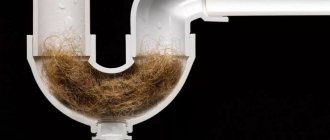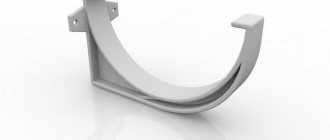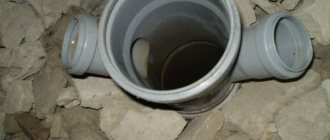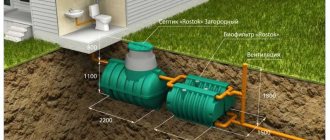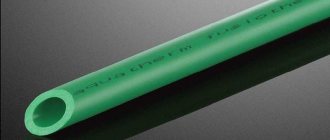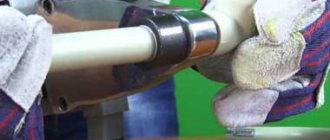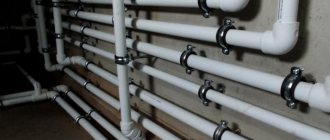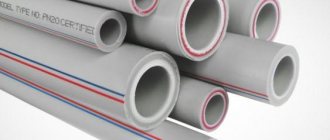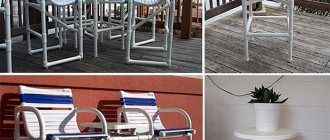Plumbing cable design
Cleaning cable with brush attachment
These plumbing products vary in length, diameter, and type of nozzle. They consist of the following elements:
- rod;
- handles used for rotation;
- nozzle that breaks up the blockage.
The most popular are products 5 meters long, the core of which is made of five strong wires and wrapped with wire in several layers, and the layers are applied in different directions - counterclockwise and clockwise. This device is sufficient for cleaning sewer pipes in an apartment or private house.
Most of the range is made from galvanized hardened steel ST70. This material is at the same time resistant to corrosion, mechanical stress, can withstand up to 3.5 thousand revolutions per minute, and is elastic. The thickness of the zinc layer, wire cross-section and other parameters must comply with GOST standards.
Dependence of cable diameter on wire cross-section
| Rope diameter (mm) | 1-1,2 | 1,4 | 1,6 |
| Wire cross-section (mm) | 1,4 | 1,9 | 2,1 |
The plumbing cable is resistant to twisting. It is used for cleaning:
- sewer and water pipes;
- pipelines fed from boilers and boilers;
- storm drain
The difference between household and professional products is significant. The latter are distinguished by their large diameter and length, the presence of comfortable handles, stands and devices that reduce the required force.
Types of cables
The cables have a common name in all cases. They differ in thickness, length and type of tip, which helps remove blockages. Starting with the smallest, cords are divided into several types.
Galvanized steel wire rope
Thickness 6 mm, length 5 m. Popular among residents of apartments and private houses, it solves problems with most blockages. It is lightweight, durable, and even an inexperienced person can use it.
Steel cable 25 m long and more than 13 mm thick
Made in the form of a spiral, the material for which is wire with a diameter of 1.8 mm.
Steel rope
One end is made in the form of a curved handle. It is considered a professional product that deals with even the most severe operational and mechanical blockages.
60-meter steel cable 16 mm thick
A 3mm thick wire wraps around a strong rod. The design allows you to adjust the rigidity of the rod, which allows it to get into the most inaccessible corners of sewer pipes. It is physically impossible to manually rotate, so these options are equipped with an electric motor.
Cable for cleaning plumbing pipes
What kind of blockages can be cleared with the product?
Hose design
Although a drain cleaning cable is considered a universal tool, not all types of clogs can be removed with it.
Operational blockage - consists of small organic deposits arising from fatty deposits, that is, food waste. The cable will clear such a blockage quickly and relatively easily.
Technological blockage - occurs in difficult sections of pipes, for example, on a bend at a large angle or when the diameter of the pipe does not match the purpose of the sewer, or when the diameter in old pipes is narrowed due to lime deposits. You can clear such an area with a cable, but the blockage will form again and again until the cause is eliminated.
Mechanical blockage - the lumen of the pipe is blocked by a large element - a rag, a bag, construction waste. In such cases, a sewer cable will not help much; it is necessary to disassemble the pipe and remove the blockage manually.
What types of blockages can be cleared using a cable?
In order to understand how to clear a sewer using a cable and in what cases it is appropriate to use it, it is necessary to consider the existing types of blockages. There are three types in total:
Sewer cable
- Operational blockage. The most common type, which is formed as a result of natural depreciation of pipes. Along with water, various small debris often penetrates into the sewer: hair, food debris, grease, etc. Once inside, they cause the formation of deposits, which further contributes to failures in the sewer system. This type of blockage can be cleared using a cable;
- Mechanical blockage. This type is most often caused by human actions that violate the rules of sewerage operation. A foreign object thrown into the toilet gets stuck in the pipe, preventing the flow of wastewater. In case of mechanical blockage, it is appropriate to use a plumbing cable, but if the object is quite large and dense, then the equipment is unlikely to be able to solve the problem. The only way out is to dismantle the pipeline;
- Technological blockage. This type occurs as a result of wear and tear on the system or if errors were initially made during the installation of the pipeline. To clear the blockage, you can use a cable. But until the sewer system is reinstalled taking into account all technical requirements, the problem will recur.
The plumbing cable copes well even with complex types of blockages and may only be ineffective in a situation where the cause of water obstruction is a large foreign object.
Types of plumbing cables
Rope rope
Existing types of cables differ in technical characteristics and features of use.
Rope (rigging) - an affordable device with a diameter of up to 6 mm and a length of 2.5 to 5 m. It looks like a tightly twisted rope made of small wires, the ends of which are crimped so that it does not unfold. But if one of its ends is developed, the product will be even more effective at clearing pipes from simple blockages, the so-called operational ones. The design is elastic and flexible, so it fits well around the bends of the sewer network.
Flexible plumbing cable (also called a flexible shaft) - its basis is a metal rod on which a metal spiral is wound, sometimes in several layers. A handle is attached to one of the ends, which is rotated in one direction when removing the blockage. This breaks down the blockage and pushes it further down the pipe to a wider area. Length – up to 60 m, diameter – up to 28 mm.
The metal tape is a flexible structure designed to break through blockages in large diameter sewer pipes. It is distinguished by the presence of a quadrangular peak at the end. Length – up to 30 m, width – up to 25 mm. When folded, it takes up less space, but is not entirely convenient, since it bends only in one plane.
The spring type is similar to a flexible shaft and consists of a coiled spring. Length – up to 25 m, diameter – up to 13.5 mm. Spring products in a plastic braid are used for cleaning plastic pipes so as not to damage the pipes themselves from the inside, as well as the cavities of the plumbing fixtures.
The tensioner is a professional equipment. It should be used to clear complex blockages when other methods have failed. The products are characterized by increased rigidity, braided metal or vinyl. The handle plays the role of a tensioner, making the cable as rigid as possible. You can optimize the device using different attachments.
Electric is a professional plumbing tool. Such a cable is used where other equipment has failed or is inconvenient to use. They have a handle like a pistol, a drill, a cable wound on a drum, and a set of tips. No need to twist, rotation is automatic.
Spring and rope devices withstand less rotational load compared to other devices, since the rope cable is made of wire of small cross-section, and in a spring product the coils can move relative to the axis.
Types of nozzles
Variety of interchangeable attachments
The attachments vary depending on the purpose. Replaceable ones are installed on a threaded connection and replaced if necessary:
- brush - used to remove organic deposits;
- auger - is a screw attachment resembling a drill, removes soft growths inside the pipe;
- punch or peak - for old and complex blockages that completely cover the lumen of the pipe;
- bottom nozzle – designed to remove construction debris;
- hook - will help you get objects that have fallen into the sewer;
- harpoon - a nozzle that combines the properties of a punch and a hook, simultaneously pierces and picks up the blockage to remove it;
- scraper - designed to remove deposits from pipe walls; it consists of two curved plates with notches.
Less popular attachments:
- in the form of a sphere - for removing sand and lime;
- tetrahedral knife - for removing roots;
- blade - for gypsum and silt deposits.
Any nozzle is selected taking into account the diameter of the pipe: the larger the diameter of the sewer, the larger the diameter of the nozzle should be.
Types of handles
Most plumbing cables for cleaning domestic drains have a rotary handle as a handle. Professional devices are equipped with a plastic or wooden handle, reminiscent of similar elements on a pistol or drill. They are equipped with an electric drive or gearbox that reduces resistance and a stand. All improvements make the process of drain cleaning easier, since the work of removing complex blockages with a long, large-diameter tool is labor-intensive.
The cost of professional devices is much higher than the price of household appliances, so they are used by plumbers who clear blockages every day. In other cases, purchasing expensive equipment is not cost-effective.
Cable attachments
The nozzles are installed on the end of the cable. With them, eliminating blockages is much faster and more efficient.
There are different types of attachments. The choice depends on the diameter of the pipe, the severity of the blockage and the type of dirt. The most common types of tips:
- In the form of a hook. Ideal for cleaning pipes from hair and fibrous debris.
- A loop. Spring steel spiral. It looks like a kitchen whisk with a sharp, severed end. Suitable for almost any purpose.
- Metal brush. Used for dense stains along the inner walls. Suitable only for metal pipes, as it severely scratches the surface.
- In the form of ticks. Used to remove greasy and viscous contaminants covering the inner walls of the pipe.
- In the shape of a spear. This tip breaks through thick clogs. Convenient if the pipe is narrow. May have teeth that firmly grip the mash when rotating.
There are also bottom nozzles, horn-shaped, rose-shaped, auger and others.
It is recommended to buy the nozzle together with the cable. Because different models have different diameters and types of fastening. A nozzle purchased at random may not be suitable.
The ideal option is to buy a cable with original attachments that come included. However, then the price will be higher.
How to choose the right accessory
Plumbing cable - an alternative to chemicals
The type and size of the sewer cleaning cable are selected taking into account the diameter of the pipes and the characteristics of the blockage. The diameter of the cable is directly dependent on the diameter of the pipes:
- to clean pipes up to 50 mm in diameter, use a cable with a diameter of no more than 10 mm;
- for pipes with a diameter of 50-110 mm, a cable of 11-15 mm in diameter is required;
- for pipes more than 110 cm in diameter - a cable with a diameter of more than 16 mm.
Moreover, to clean the sewerage system within an apartment, a tool with a diameter of 6-10 mm is sufficient, for a common one - 12-16 mm, for an industrial one - 16-20 mm.
To clean a small-diameter plastic pipe, use a thin flexible cable with a diameter within a centimeter.
The more turns the sewer system being cleaned has, the thinner the wire from which the cable is made should be.
For cleaning long systems with medium-sized pipes, the diameter of the cable may be slightly larger than recommended, but it is important that it is quite flexible.
Dependence of the thickness of the plumbing cable for cleaning sewers on the diameter of the pipeline
Before you buy a sewer cleaning cable, you need to understand the dimensions and functionality of the product. Taking into account the scope of application, an indicator such as thickness is selected. This value is important in order to select a product for specific pipe parameters. If the size of the line is less than 50 mm, then the device must be selected with a cross-section of less than 10 mm. With a diameter of up to 100 mm, the cable is selected with a cross-section of up to 16 mm. If the size of the line is even larger, then the thickness of the product can be more than 16 mm.
Device sizes
How to make a cable with your own hands
The base is made of flexible twisted wire. Thick wire is not used, as it bends poorly. To make it easier to remove the blockage, the tip of the wire is flattened with a hammer or fluffed. The opposite end is bent into a ring to make it convenient to hold. A homemade device is used to clean sewers 3-5 m long.
Another option is a gas flexible hose. A nozzle is attached to one end with a reliable connection so that it does not unscrew during the process and does not remain inside the pipe.
The third option is a steel cable. All you need to do is select a piece of the required length and fluff the tip like a brush. And so that it does not unravel where it is not necessary, at some distance from the end it is fastened with a metal wire clamp.
The fourth option is a device made from a plastic bottle. It is cut in a spiral, creating a long ribbon. It is cut along the edges, making many small notches that will effectively clean the walls of the pipe.
Types of nozzles for sewer cable
The elements that clog the sewer can be different. Original tips were created to remove each type of debris:
- layers of organic substances are removed by a “ruff”;
- the punching nozzle helps eliminate problematic, stubborn blockages;
- a bottom nozzle with a body made of durable material is used to clean the system from small construction debris, lime deposits, and heavy solid particles;
- the tip with a hook helps to grab and remove large objects;
- the loop attachment eliminates the water seal.
How to clean a pipe
Using a plumbing cable
Most often, a blockage occurs in the siphon, so before using the cable, first unscrew the siphon and wash it. This will solve the problem in most cases.
Before starting work, inspect the cable for clearing a clogged drain for damage, since a piece of tool stuck in the pipe will only aggravate the problem. In addition, it is recommended to lubricate the rotating elements.
Next, proceed according to the following instructions:
- An oilcloth is laid on the floor. Put rubber gloves on your hands.
- After unscrewing the siphon and removing the sealing plug from the outlet pipe, the end of the cable with the nozzle on it is lowered into the drain of the sink, bathtub or toilet.
- The tool is pushed deeper and deeper by pushing it with one hand and turning the handle clockwise with the other. The tool is gradually unwound. When the cable encounters a blockage, it will be more difficult to turn it, but the speed will increase. In difficult cases, the cable is removed from the pipe, cleaned and lowered into the pipe again, continuing to break through the blockage with jerking movements.
- When the plug is removed, rotation will immediately become easier.
- After removing the blockage, rotate the handle for some time to get rid of the blockage completely. This will not allow it to settle in a new place and will completely destroy it.
- At the end, flushing the drain with hot water is necessary to completely remove any remaining blockage.
After making sure that the problem has been resolved, the siphon is installed in place, and the cable is put away for storage.
Cleaning with chemicals
In some situations, working with a plumbing cable is not possible or does not have the required efficiency. For example, if the pipe is clogged with fecal matter or mineral clots. In this case, you will need to break through the sewer with chemicals at hand.
It is best to work with soda in the toilet and bathroom - this natural reagent will help cope with almost any type of dirt. To break through a pipe with soda, you need to turn off the water supply, then pour the pack into the toilet and wait 10 minutes. Next, fill the hole with a glass of vinegar and wait about an hour. This technique has proven itself to be effective in the fight against fecal accumulations and greasy sediments.
Be careful - vinegar with such a symbiosis emits an unpleasant odor, which is toxic fumes. If you inhale it carelessly, you can burn your respiratory tract. This method is good for small problems. If you have a long-term accumulation on the walls of the pipeline, then it is better to use more professional methods.
Using traditional methods, you can break through the sewer without vinegar. You just need to first fill the channel with soda, and then fill it with hot water. This method is also suitable for cleaning the toilet of a private home. We recommend periodically passing soda through the pipelines.
Photo - chemicals for punching
Often in a private house and apartment, sewers are pierced with a special powder and liquid “Mole”. This is a universal remedy. The peculiarity is not only high efficiency, but also a wide spectrum of action. The product helps get rid of unpleasant odors, dirt, and mineral deposits. You need to pour in approximately 250 grams of powder or a glass of liquid, then wait 2 hours and pour hot water over the drain.
Video: DIY pipe cleaner
An effective way is to clean the kitchen drain with Domestos; it can quickly break through even complex greasy stains. Pour about 100 grams of solution from the sink, then leave for a while. After half an hour, you can flush the channel with hot water. The same option can be used in the toilet, but first you need to flush all the water so that the chemical does not dissolve in it and does not change its concentration.
Sometimes the cause of clogged drains is frozen water. This often happens in a private house on an external drain line. If you have such a problem, then under no circumstances should you pour hot water over the surface of the pipe. Step-by-step instructions on how to break through a frozen sewer:
- If the system is located in the yard, then you need to dig it out and open the lines. In this case, it is very important to find the location of the ice;
- To determine exactly where the blockage is, run a cable into the pipe and push it until it stops. Next, to measure the distance, take the wall as a basis and measure the length of the cable from it. This way you will find the approximate location of ice formation;
- Hot water poured into the pipe will not help. When cooling, it will interfere with the progress of the warm stream and, ultimately, can only expand the boundaries of the congestion. You need to wrap the pipe with a textile blanket and pour boiling water on it. This must be done for a very long time until the duct resumes.
Tips and tricks
Useful tips will help you clean the drain efficiently and keep your tool in good condition for a long time:
- After use, the cable must be washed, dried well, lubricated with technical oil and put into a paper bag or wrapped in paper, rolling the tool into a coil. It is not recommended to store it in a sealed plastic bag.
- When cleaning the sewer, hold the shaft with the other hand, controlling the progress of the work.
- When flushing the drain after removing the blockage, you can add a degreaser to the water.
If the water forms a funnel when draining, it means that the sewer has been cleaned efficiently.
How to clean a drain with a cable
Working with a cable is not difficult, and any owner will do it without difficulty if he knows the sequence of operations:
- First, check the homemade or factory-made device for integrity and functionality (broken cable threads, rotation of the handle, kinks, compliance with length and diameter);
- Preparatory work: lay oilcloth or polyethylene on the floor so as not to stain the floor covering;
- Wear rubber gloves;
- Remove the siphon and plug, rinse it all with water;
- Start working with a cable or cord.
More information on how to clean a pipe with a cable, cord or wire:
- One end of the cable or wire with a nozzle is inserted into the drain hole;
- Scroll the handle while simultaneously immersing the tool in the hole;
- When it becomes difficult to turn, it means that the wire has hit a blockage, but continue turning, moving the wire up and down until the blockage goes away;
- After removing the blockage, it is recommended to turn the cable several more times to make sure there is no blockage;
- The last step is to flush the drainage pipes with hot water.
The tool (brush, cable, cord or wire) is also washed with hot water and lubricated with any thick machine lubricant. Even a person who has never held any household tool in his hands before can cope with such a simple problem.
